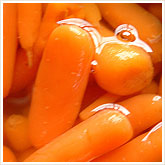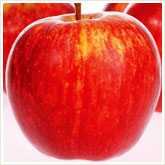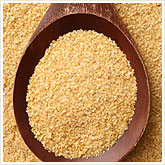What's The 4-1-1 on
Fiber? By Omar Shamout
From Team Beachbody - Click here for resources, tools and
information to help you to reach your health, fitness and positive lifestyle
goals!
When I was very young, my mother implored me
to eat my bran flakes or else I wouldn't get enough fiber. I don't know about
you, but from the age of 4 on, anything my mother told me to do automatically
seemed worth avoiding at all costs. Plus the word "bran" kind of sounds like
"bland," so it's like my mind was already telling me I was going to dislike it
even before I tried it. But in hindsight, maybe my mother knew what she was
talking about. Fiber is essential to maintaining a healthy digestive system,
and it also has a positive effect on your heart, cholesterol levels, and blood
sugar.

What is fiber?
Fiber is a complex carbohydrate found in
fruit, vegetables, whole grains, and legumes. In fact, it's so complex the body
can't digest it.
Note that I said whole grains. When
it comes to grains, you'll find the fiber in the outer shell, or bran (there's
that word again). The problem we face in getting fiber from bread, pasta, rice,
or cereal—the processed foods many of us know and love—is that
they're often made from refined grains that have been stripped of their bran,
which means they contain very little fiber. And just because a product says
"wheat" somewhere on the bag or box doesn't mean it has fiber in it.
(Technically, Wonder® Bread is made from wheat.) If you want to
make sure you're getting your whole grains, and the fiber that comes along with
them, you need to verify that the ingredients actually list "whole wheat" or
another kind of whole grain. And even then, you should check the fiber listing
on the nutrition facts panel to see how much you're getting.
What does fiber do?
 There are two types of
fiber: insoluble and soluble. Insoluble fiber goes through your system "as is"
and helps to regulate bowel movements. As insoluble fiber moves through the
digestive tract and colon, it carries other things along with it, which bulks
up your stool, making it easier for it to pass. If one of your goals is weight
loss, consuming more insoluble fiber is helpful, because it helps you eliminate
more waste from your body. There are two types of
fiber: insoluble and soluble. Insoluble fiber goes through your system "as is"
and helps to regulate bowel movements. As insoluble fiber moves through the
digestive tract and colon, it carries other things along with it, which bulks
up your stool, making it easier for it to pass. If one of your goals is weight
loss, consuming more insoluble fiber is helpful, because it helps you eliminate
more waste from your body.
Soluble fiber dissolves in water, taking on
a gel-like consistency in the stomach, helping to slow digestion and lower
blood sugar levels by slowing the rate at which sugar is released into the
blood. Soluble fiber also helps to regulate cholesterol by binding with fatty
acids and helping them to be eliminated from your system. Fiber has been shown
to reduce the risk of coronary artery (heart) disease and type 2 diabetes.
Here's a chart that breaks down how much fiber the USDA recommends adults
consume daily to maintain a healthy diet:
| |
Age 50 and
Younger |
Age 51 and
Older |
| Men |
38 g |
30 g |
| Women |
25 g |
21 g |
But I don't like the way fiber-rich foods
taste!
We get it, and food manufacturers do
too—they realize consumers have gotten increasingly savvy about what goes
into their food (and subsequently, into their bodies), and are offering more
and more whole-grain versions of many of their popular brands of products.
Taste preference, especially for foods made from refined flour, has a great
deal to do with what you're used to. Making a commitment to buying whole-grain
products requires your taste buds to adapt, but learning to prepare whole-grain
foods in a way that's appealing and combining them with other other nutritious
foods can result in healthy meals that are also good to eat.
It's important to realize you don't need to
change everything about the way you eat overnight. Small changes can
add up. If you don't like whole-grain bread, start with adding more apples or
beans to your diet. Have fun and experiment. Don't get frustrated because you
don't like eating bran muffins and proclaim that fiber isn't worth the trouble.
There are always solutions to a problem if you're patient enough to find them.
One great resource for gourmet, high-fiber recipes is The High-Fiber
Cookbook by Bryanna Clark Grogan.
Supplements, you say?
If you change your diet and you're still not
getting all the fiber you need, supplements are a great way to boost your fiber
intake. One main drawback of getting your fiber as a supplement is that you can
deprive your body of the other vitamins and minerals you'd be consuming along
with the fiber you get in natural food form. If a food is high in fiber, it's
probably high in many other things that are good for you too, and you end up
killing eight essential birds (or vitamins) with one stone (or bowl of lentil
soup). Keeping this in mind, let's explore four popular forms of fiber
supplements:
 Apple pectin.
Pectin is a compound found primarily in apples, but also
in other fruits, including plums and citrus. It's useful in aiding ongoing
conditions, like diarrhea, irritable bowel syndrome, and other digestive
disorders. It's also an antioxidant, and antioxidants have been shown to have a
positive effect in reducing the risk of certain cancers, and lowering
cholesterol in the bloodstream. As a result, it's recommended especially highly
for those who consume a high-fat diet. Apple pectin.
Pectin is a compound found primarily in apples, but also
in other fruits, including plums and citrus. It's useful in aiding ongoing
conditions, like diarrhea, irritable bowel syndrome, and other digestive
disorders. It's also an antioxidant, and antioxidants have been shown to have a
positive effect in reducing the risk of certain cancers, and lowering
cholesterol in the bloodstream. As a result, it's recommended especially highly
for those who consume a high-fat diet.- Psyllium husk.
The dried covering of plant seeds, psyllium husk contains
a whopping 71 grams of fiber in only one-third of a cup. Some people are very
allergic to psyllium husk, so always consult your doctor before adding this or
any other new supplement to your diet. One side effect of psyllium husk powder,
and high-fiber diets in general, is that it can give you gas. A lot of gas. The
best way to deal with this unfortunate problem is to increase your daily fiber
intake slowly. A sudden increase of 20 grams of fiber or more per day can cause
discomfort, so allow your body to become comfortable with a new diet, and don't
rush into it. Also, popular fiber supplements like Metamucil®
merely combine psyllium husk with sugar, so you're better off skipping the
sweetness and going for the real thing.
- Flaxseed.
Flaxseed is a wonderful plant food because not only does
it contain both soluble and insoluble fiber, but it also has high amounts of
omega-3 fatty acids, which are believed to greatly reduce the risk of
atherosclerosis, help lower blood pressure and cholesterol, and help fight
different types of cancers, specifically of the colon, prostate, and breast.
Lignans found in flaxseed have also been proven to prevent the incidence and
growth rate of tumors in cancers that are sensitive to hormones. One or two
tablespoons of ground flaxseed daily is the suggested dose, and it can easily
be added to foods like yogurt, cereal, soup, etc. However, women who are
pregnant or breastfeeding are advised not to supplement their diet with
flaxseed until further studies examining its effect on them are concluded, and
again, it's important to consult with your physician about adding any
supplements to your diet.
 Wheat germ.
Wheat germ is another good source of omega-3 fatty acids
and fiber, but it's especially valuable for its high quantities of vitamin B,
which aids in regulating metabolism and stress levels, and vitamin E, which
benefits the skin. Wheat germ.
Wheat germ is another good source of omega-3 fatty acids
and fiber, but it's especially valuable for its high quantities of vitamin B,
which aids in regulating metabolism and stress levels, and vitamin E, which
benefits the skin. |
Whether you do it because Beachbody
suggested it, or because you think it's about time you finally heeded some of
your mother's advice, it's not a bad idea to figure out a way to get the
recommended amount of fiber in your diet. It may help you achieve a smaller
waistline, while also helping to stave off a myriad of dangerous diseases.
That's gotta be worth a bran muffin or two . . . right?
References and Further
Reading:
- Merck.com, "Coronary Artery
Disease," James Wayne Warnica, MD. February, 2008.
- Oprah.com, "Fiber Supplement
Safety," David L. Katz, MD. May 12, 2009
- Mayoclinic.com, "Diabetes
Prevention: 5 Steps to Taking Control."
http://www.mayoclinic.com/health/diabetes-prevention/DA00127.
|

|